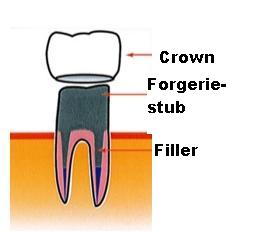When a nerve has been removed from the roots, we talk about a "root-treated tooth" or devitalised tooth.
This treatment must be applied when the cavity has reached the nerve.
Consequences:
Since the tooth is no longer alive, it becomes fragile and brittle, as dead wood would.
It can break at any time, and this can lead to losing the tooth.
Treatment:
To strengthen the tooth and avoid as much as possible any risk of breakage or having to remove the tooth, ours dentists in Lille (59000 ) and Neufchatel-Hardelot (62152) near Boulogne sur meat cover the tooth with a crown the will protect it.
Materials commonly used to create crowns:
Metallic alloys:
Steel: this is a metallic alloy using nickel and chromium, which can provoke corrosive and allergic reactions.
White Gold: this half-precious alloy is a good compromise, providing good electrochemical qualities and holding well in the mouth.
Yellow gold: high mechanical and electrochemical qualities material.
Cosmetic Materials:
Resin: we use it to create temporary crowns (until the final crown is ready). Its mechanical and aesthetics qualities are sustainable for a 6 months' maximal duration.
Ceramic: It is the best cosmetic reference material. It provides strength, aesthetics and physical integrity. With or without metallic armature, ceramic crowns can be used in any situation, even the most complex.
Restoration
In some cases, we have to restore an overly damaged tooth before we set the crown.
There are 2 methods, using an imprint from the tooth:
Inlay-Core: we ask the prosthodontist to create a metallic structure which will be cemented in the root.
Pins based Reconstitution: we use non metallic materials. The resin is reinforced using titanium pins which are glued to the wall of the teeth.

